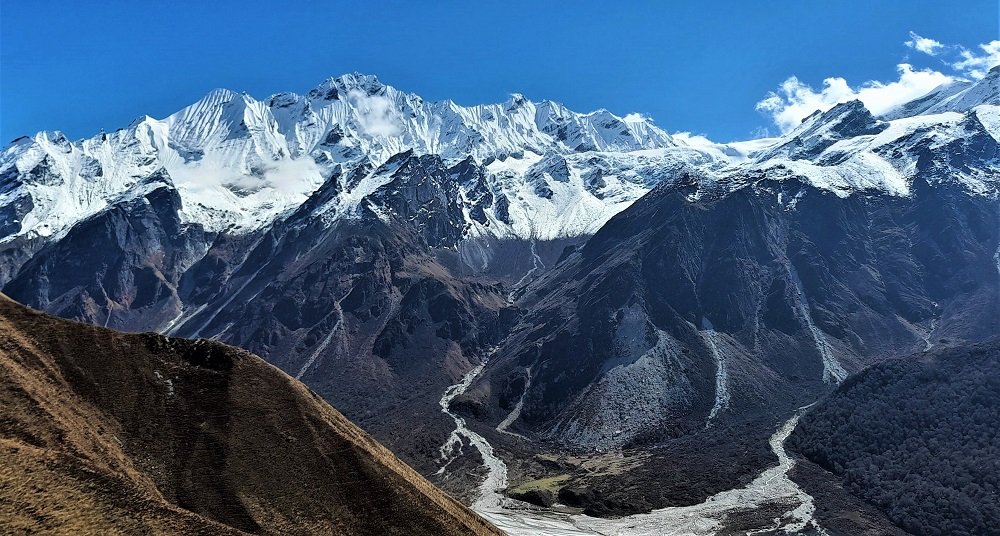Everything you need to know about Ganja La Pass | Interesting things about Ganja La Pass
Ganja La Pass is a challenging high mountain pass located in the Langtang region of Nepal. It is one of the popular trekking routes for experienced trekkers and mountaineers seeking an adventurous and remote trekking experience. Here's everything you need to know about Ganja La Pass:
1. Location:
Ganja La Pass is situated in the Langtang region of Nepal, which lies to the north of Kathmandu. It is part of the Langtang National Park and is surrounded by majestic Himalayan peaks. The pass lies at an elevation of approximately 5,106 meters (16,752 feet) above sea level.
2. Trekking Route:
The trek to Ganja La Pass typically starts from Syabrubesi, a village that serves as the gateway to the Langtang region. From there, trekkers follow a scenic trail that passes through lush forests, charming villages, and rugged terrain. The route takes you to popular stops such as Lama Hotel, Langtang Village, Kyanjin Gompa, and finally to the Ganja La Pass itself. After crossing the pass, the trail descends to Helambu or retraces the same route back to Syabrubesi.
3. Difficulty Level:
The trek to Ganja La Pass is considered a challenging and demanding trek suitable for experienced trekkers. It requires a good level of physical fitness, prior trekking experience, and the ability to navigate difficult terrains. The pass crossing involves steep ascents and descents, rocky sections, and the need to negotiate snow and ice, particularly during the winter and early spring months. Trekkers should be prepared for long and strenuous hiking days.
4. Altitude Acclimatization:
As the trek takes you to high altitudes, proper acclimatization is crucial to minimize the risk of altitude sickness. The itinerary usually includes rest days and gradual ascents to allow the body to adapt to the decreasing oxygen levels. It is essential to stay hydrated, take regular breaks, and listen to your body's signals during the trek.
5. Scenic Beauty:
The Ganja La Pass trek offers breathtaking natural beauty throughout the journey. The trail winds through dense forests of rhododendron, oak, and bamboo, providing glimpses of wildlife and bird species. As you ascend, you'll be rewarded with stunning views of snow-capped peaks, including Langtang Lirung, Dorje Lakpa, Yala Peak, and others. The landscapes range from lush green valleys and terraced fields to barren alpine regions adorned with glacial lakes and majestic glaciers.
6. Ganja La Pass Crossing:
The crossing of Ganja La Pass itself is a highlight of the trek. The pass stands at an elevation of around 5,106 meters (16,752 feet), offering panoramic views of the surrounding mountains. The ascent and descent involve steep sections with loose rocks, icy slopes, and the need to navigate crevasses, particularly during the snowy seasons. It is recommended to have proper trekking equipment, including crampons, ice axes, and ropes, and to be accompanied by an experienced guide.
7. Remote and Less Crowded:
The Ganja La Pass trek is known for its remote and off-the-beaten-path nature. Compared to popular treks like Everest Base Camp or Annapurna Circuit, this route sees fewer trekkers, providing a sense of solitude and tranquility in the mountains. You'll have the opportunity to immerse yourself in the serene beauty of the Langtang region and experience a more authentic and less commercialized trekking adventure.
8. Camping and Accommodation:
Due to the remote nature of the trek, camping is the primary accommodation option for trekkers. Carrying camping gear, including tents, sleeping bags, and cooking equipment, is necessary. The trail offers designated camping spots with beautiful views, and the experience of sleeping under starry skies amidst the Himalayan wilderness is truly memorable. In some lower sections, basic teahouses and lodges may be available, but they are limited.
9. Weather and Best Time to Trek:
The weather in the Ganja La Pass region is influenced by the monsoon season (June to August) and the winter season (December to February). The best time to undertake this trek is during the spring (March to May) and autumn (September to November) seasons. These months offer stable weather, clear skies, and comfortable temperatures for trekking. However, treks during the winter are possible for experienced trekkers, although the pass crossing may be more challenging due to heavy snowfall and extreme cold temperatures.
10. Permits:
To trek in the Langtang region, including Ganja La Pass, you need to obtain the Langtang National Park Entry Permit and the TIMS (Trekkers' Information Management System) card. These permits can be obtained in Kathmandu or at the park entrance in Syabrubesi. It's important to have these permits with you throughout the trek.




.jpg)



